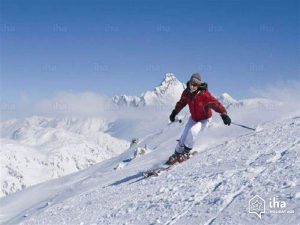Ski fitness – Preparing for the ski season.
Focusing on proper ski fitness prior to your ski trip could save endless regrets when you hit the slopes. Surprisingly, for a sport that is considered to be so dangerous, the statistics on skiing injuries is lower than you might expect. Typically, there is an injury incidence rate of about 2.5 per 1000 skier days. So thankfully, as long as you don’t go crazy, you should remain injury free.
However, when they do occur, skiing injuries can be particularly nasty. Torn knee ligaments or dislocated shoulders can cause years of repercussions. It is best to give yourself the best chance of staying injury free. And, of course, improving your fitness before skiing will increase your overall enjoyment of your trip anyway.

Ski Fitness
Proper preparation for skiing
Realistically, any tangible benefits you will get from a change in your fitness programme will take a few weeks to kick in. Depending on your current level of fitness it can take anywhere from 4 to 8 weeks to make a measurable difference to your fitness. The earlier you get started on a pre-skiing regime the better. However, rather than just jumping into an exercise programme you should consider getting an assessment first.
Most people associate skiing with strength training and endurance training, but balance and flexibility are also key. A critical component of good balance is good muscle balance. It is definitely worth a visit to a qualified physiotherapist prior to starting your training to get a thorough assessment of your strengths and weaknesses. It is always better to know how to claim compensation for the injury caused out of third party negligence during skiing .
It also a good idea to invest in some sports massage as a form of pre-habilitation for both your training programme and the skiing itself. The better prepared you are before you go head-on into your training regime, the better the results you will get.
Some great exercises for proper ski fitness
As you would expect, the thighs and the glutes are essential in skiing. It is worth remembering, that skiing is a dynamic activity. Traditional exercises such as the leg press will help, but you need to build in squats (and if appropriate for your level) jump squats into your routine.
An area that is often overlooked during preparation is the core. The core muscles help protect the spine, and good posture is important to helping to avoid fatigue whilst skiing. If you go to a gym, ask one of the trainers to show you variations on the old-fashioned plank exercise. There are now many variations of the plank that involve more movement and are far better for activating the abdominals.
To improve balance consider investing in a wobble cushion. The cushion is also ideal for a range of exercises that are designed to help the function and strength of leg and foot joints as well as helping the user with general exercising and strengthening core stability
And finally, with regard to building cardiovascular fitness, cycling is preferable to running or swimming. Cycling uses a lot more of the muscles that are specific to skiing.
We hope this information is useful for you. If you have any questions about our treatments, please contact us. You can find us in Islington and in Mill Hill Broadway. If you like this blog, please share!



